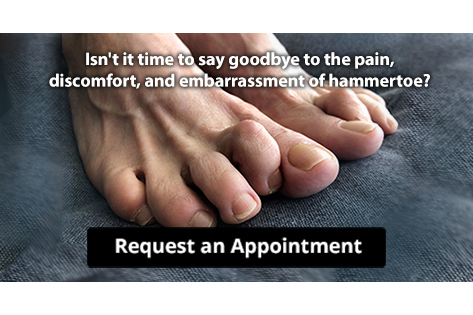Items filtered by date: April 2024
What to Do About a Pinched Foot Nerve
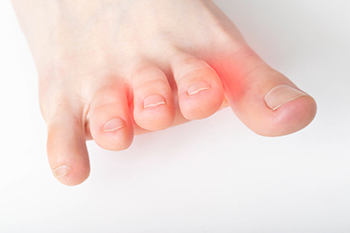
Pinched nerves in the foot, beyond tarsal tunnel syndrome, stem from diverse conditions, necessitating accurate diagnosis for effective treatment. Morton's neuroma, characterized by nerve thickening between toes, and hammertoes, involving abnormal toe bending, can both compress nerves. Additionally, bunion formation at the big toe base can crowd and irritate nearby nerves. Nerve entrapment, resulting from injury or structural abnormalities, and peripheral neuropathy, often associated with diabetes, can also contribute to nerve compression. Symptoms may encompass tingling, numbness, or burning sensations, affecting mobility and comfort. Precise diagnosis by a podiatrist is important for targeted intervention. Treatment may involve a combination of conservative measures such as rest and orthotic devices. In some cases, corticosteroid injections or surgical procedures may be necessary for relief. If you have the symptoms described above, it is suggested that you schedule an appointment with a podiatrist for a proper diagnosis and treatment.
Morton’s neuroma is a very uncomfortable condition to live with. If you think you have Morton’s neuroma, contact Neeta Hasmukh, DPM of Total Podiatry. Our doctor will attend to all of your foot care needs and answer any of your related questions.
Morton’s Neuroma
Morton's neuroma is a painful foot condition that commonly affects the areas between the second and third or third and fourth toe, although other areas of the foot are also susceptible. Morton’s neuroma is caused by an inflamed nerve in the foot that is being squeezed and aggravated by surrounding bones.
What Increases the Chances of Having Morton’s Neuroma?
- Ill-fitting high heels or shoes that add pressure to the toe or foot
- Jogging, running or any sport that involves constant impact to the foot
- Flat feet, bunions, and any other foot deformities
Morton’s neuroma is a very treatable condition. Orthotics and shoe inserts can often be used to alleviate the pain on the forefront of the feet. In more severe cases, corticosteroids can also be prescribed. In order to figure out the best treatment for your neuroma, it’s recommended to seek the care of a podiatrist who can diagnose your condition and provide different treatment options.
If you have any questions, please feel free to contact our offices located in San Antonio, Uvalde, and Jourdanton, TX . We offer the newest diagnostic and treatment technologies for all your foot care needs.
Dangers of Falls Among Seniors
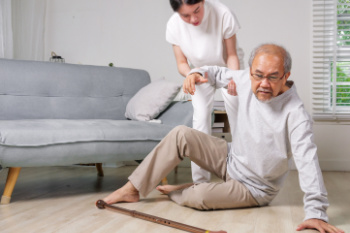
As you age, the risk of falls becomes a serious concern. Statistics reveal that more than one-fourth of older adults experience a fall each year. Many falls go unreported to doctors despite the doubled chances of falling again after the first incident. Falls often result in severe consequences, such as broken bones or head injuries that may compromise physical health and reduce independence. Contributing factors to falling include foot pain or wearing poorly fitting footwear. Additionally, lower body weakness, vision problems, and medication side effects can contribute to the risk of falls in older adults. To help prevent falls, seniors are encouraged to schedule appointments with a podiatrist to assess foot health, footwear, and gait abnormalities. Engaging in regular strength and balance exercises can help by improving stability and reducing fall risk. Regular eye exams and updating eyeglasses as needed can enhance visual clarity, especially for outdoor activities. Making the home environment safer by eliminating trip hazards, installing grab bars in bathrooms, and ensuring adequate lighting is also important in fall prevention. If you have injured your feet during a fall, it is suggested that you schedule an appointment with a podiatrist.
Preventing falls among the elderly is very important. If you are older and have fallen or fear that you are prone to falling, consult with Neeta Hasmukh, DPM from Total Podiatry. Our doctor will assess your condition and provide you with quality advice and care.
Every 11 seconds, an elderly American is being treated in an emergency room for a fall related injury. Falls are the leading cause of head and hip injuries for those 65 and older. Due to decreases in strength, balance, senses, and lack of awareness, elderly persons are very susceptible to falling. Thankfully, there are a number of things older persons can do to prevent falls.
How to Prevent Falls
Some effective methods that older persons can do to prevent falls include:
- Enrolling in strength and balance exercise program to increase balance and strength
- Periodically having your sight and hearing checked
- Discuss any medications you have with a doctor to see if it increases the risk of falling
- Clearing the house of falling hazards and installing devices like grab bars and railings
- Utilizing a walker or cane
- Wearing shoes that provide good support and cushioning
- Talking to family members about falling and increasing awareness
Falling can be a traumatic and embarrassing experience for elderly persons; this can make them less willing to leave the house, and less willing to talk to someone about their fears of falling. Doing such things, however, will increase the likelihood of tripping or losing one’s balance. Knowing the causes of falling and how to prevent them is the best way to mitigate the risk of serious injury.
If you have any questions, please feel free to contact our offices located in San Antonio, Uvalde, and Jourdanton, TX . We offer the newest diagnostic and treatment technologies for all your foot care needs.
Causes and Treatment of an Achilles Tendon Injury
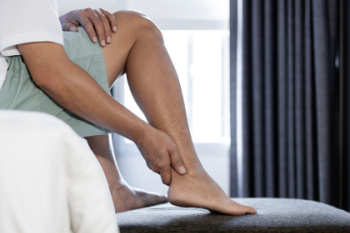
Achilles tendon injuries are common for both athletes and occasional exercisers, presenting significant challenges due to the tendon's pivotal role in mobility. Often triggered by overuse, athletes may push their limits too quickly or neglect proper stretching before physical activity. Also, factors like wearing high heels or foot issues like flat feet can heighten the risk of an Achilles tendon injury. Symptoms typically include pain along the back of the foot and above the heel, and can be worsened by ankle stretching or toe-standing. Diagnosis involves a thorough physical examination by a podiatrist, who also may order imaging tests like an ultrasound or MRI scans to assess the extent of damage. Treatment options vary based on severity and may include prescribing anti-inflammatory medication or certain exercises for rehabilitation. In severe cases or complete tears, surgery may be necessary for tendon repair. If you have injured your Achilles tendon, it is suggested that you schedule an appointment with a podiatrist for a full exam, diagnosis, and suggested treatment plan.
Achilles tendon injuries need immediate attention to avoid future complications. If you have any concerns, contact Neeta Hasmukh, DPM of Total Podiatry. Our doctor can provide the care you need to keep you pain-free and on your feet.
What Is the Achilles Tendon?
The Achilles tendon is a tendon that connects the lower leg muscles and calf to the heel of the foot. It is the strongest tendon in the human body and is essential for making movement possible. Because this tendon is such an integral part of the body, any injuries to it can create immense difficulties and should immediately be presented to a doctor.
What Are the Symptoms of an Achilles Tendon Injury?
There are various types of injuries that can affect the Achilles tendon. The two most common injuries are Achilles tendinitis and ruptures of the tendon.
Achilles Tendinitis Symptoms
- Inflammation
- Dull to severe pain
- Increased blood flow to the tendon
- Thickening of the tendon
Rupture Symptoms
- Extreme pain and swelling in the foot
- Total immobility
Treatment and Prevention
Achilles tendon injuries are diagnosed by a thorough physical evaluation, which can include an MRI. Treatment involves rest, physical therapy, and in some cases, surgery. However, various preventative measures can be taken to avoid these injuries, such as:
- Thorough stretching of the tendon before and after exercise
- Strengthening exercises like calf raises, squats, leg curls, leg extensions, leg raises, lunges, and leg presses
If you have any questions please feel free to contact our offices located in San Antonio, Uvalde, and Jourdanton, TX . We offer the newest diagnostic tools and technology to treat your foot and ankle needs.
Managing Fungal Toenail Infections
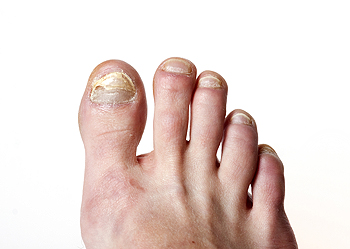
Fungal toenail infections can be recognized by the slow development of discolored, thickened, and distorted nails, often accompanied by discomfort. Although not typically serious, fungal toenail infections can be bothersome and challenging to address. Fungal toenail infections typically arise from fungi prevalent in warm, moist environments, like gym locker rooms. Contributing factors include poor foot hygiene, sweaty footwear, and exposure to communal areas where people are likely to be barefoot. Treatment options encompass antifungal medications, although it may take a long time and cause side effects. While mild cases may resolve without intervention, severe infections often necessitate medical attention. It is suggested that you schedule an appointment with a podiatrist for an accurate diagnosis and options for more advanced treatment.
If left untreated, toenail fungus may spread to other toenails, skin, or even fingernails. If you suspect you have toenail fungus it is important to seek treatment right away. For more information about treatment, contact Neeta Hasmukh, DPM of Total Podiatry. Our doctor can provide the care you need to keep you pain-free and on your feet.
Symptoms
- Warped or oddly shaped nails
- Yellowish nails
- Loose/separated nail
- Buildup of bits and pieces of nail fragments under the nail
- Brittle, broken, thickened nail
Treatment
If self-care strategies and over-the-counter medications does not help your fungus, your podiatrist may give you a prescription drug instead. Even if you find relief from your toenail fungus symptoms, you may experience a repeat infection in the future.
Prevention
In order to prevent getting toenail fungus in the future, you should always make sure to wash your feet with soap and water. After washing, it is important to dry your feet thoroughly especially in between the toes. When trimming your toenails, be sure to trim straight across instead of in a rounded shape. It is crucial not to cover up discolored nails with nail polish because that will prevent your nail from being able to “breathe”.
In some cases, surgical procedure may be needed to remove the toenail fungus. Consult with your podiatrist about the best treatment options for your case of toenail fungus.
If you have any questions please contact our offices located in San Antonio, Uvalde, and Jourdanton, TX . We offer the newest diagnostic and treatment technologies for all your foot and ankle needs.
Do You Suffer From Painful Feet?
Children’s Foot and Heel Pain Causes
 Children's foot and heel pain, or CFHP, encompasses a variety of conditions that can impact children’s ability to engage in activities and sports without discomfort. One common cause of CFHP is Sever's disease, a condition that results from inflammation of the growth plate in the heel. Sever’s disease is often seen in active children undergoing growth spurts. Additionally, flat feet or overpronation can strain the foot's muscles and ligaments, causing pain. Improper footwear, intense physical activity, and obesity may also contribute to the development of CFHP. Symptoms typically include pain in the foot or heel, particularly during or after physical activities, and might be accompanied by swelling or redness. Addressing CFHP involves a combination of rest, wearing appropriate footwear, and sometimes orthotic devices to support the foot's structure. Early diagnosis and treatment are important to prevent chronic problems and ensure that children can participate in their favorite activities without pain. If your child is suffering with foot or heel pain, it is suggested that you schedule an appointment with a podiatrist today.
Children's foot and heel pain, or CFHP, encompasses a variety of conditions that can impact children’s ability to engage in activities and sports without discomfort. One common cause of CFHP is Sever's disease, a condition that results from inflammation of the growth plate in the heel. Sever’s disease is often seen in active children undergoing growth spurts. Additionally, flat feet or overpronation can strain the foot's muscles and ligaments, causing pain. Improper footwear, intense physical activity, and obesity may also contribute to the development of CFHP. Symptoms typically include pain in the foot or heel, particularly during or after physical activities, and might be accompanied by swelling or redness. Addressing CFHP involves a combination of rest, wearing appropriate footwear, and sometimes orthotic devices to support the foot's structure. Early diagnosis and treatment are important to prevent chronic problems and ensure that children can participate in their favorite activities without pain. If your child is suffering with foot or heel pain, it is suggested that you schedule an appointment with a podiatrist today.
The health of a child’s feet is vital to their overall well-being. If you have any questions regarding foot health, contact Neeta Hasmukh, DPM of Total Podiatry. Our doctor can provide the care you need to keep you pain-free and on your feet.
Tips for Keeping Children's Feet Healthy
- Make sure their shoes fit properly
- Look for any signs of in-toeing or out-toeing
- Check to see if they have Clubfoot (condition that affects your child’s foot and ankle, twisting the heel and toes inward) which is one of the most common nonmajor birth defects.
- Lightly cover your baby’s feet (Tight covers may keep your baby from moving their feet freely, and could prevent normal development)
- Allow your toddler to go shoeless (Shoes can be restricting for a young child’s foot)
- Cut toenails straight across to avoid ingrown toenails
- Keep your child’s foot clean and dry
- Cover cuts and scrapes. Wash any scratches with soap and water and cover them with a bandage until they’ve healed.
If you have any questions, please feel free to contact our offices located in San Antonio, Uvalde, and Jourdanton, TX . We offer the newest diagnostic and treatment technologies for all your foot care needs.
